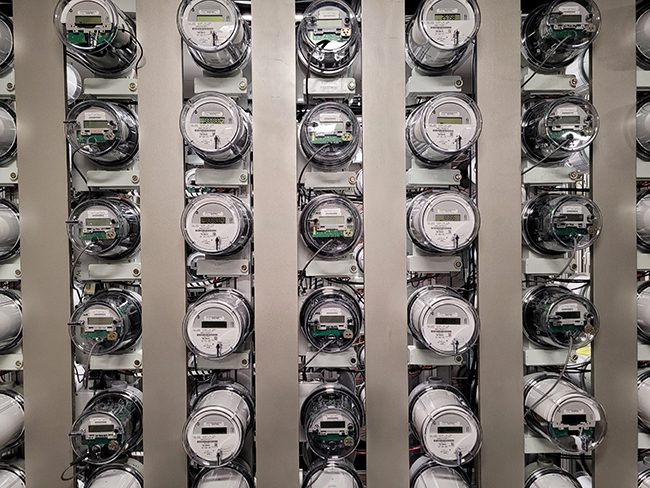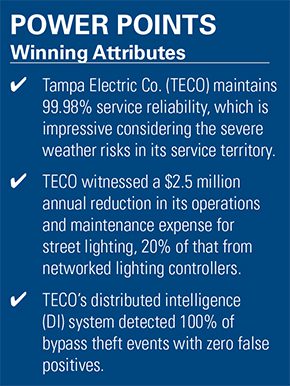TECO Achieves Highly Reliable Power Grid Service with Advanced Technology

Tampa Electric Company (TECO) has enhanced its power system operation through the adoption of advanced technology. Its pioneering culture and the benefits obtained with these new innovative tools have led to its selection as POWER’s 2023 Smart Grid Award winner.
Tampa Electric Company (TECO) began supplying the Tampa Bay area with electricity in 1899. Today, TECO is a subsidiary of Emera Inc., a geographically diverse energy and services company headquartered in Halifax, Nova Scotia, Canada, that has investments throughout North America and in four Caribbean countries. For its part, TECO’s service territory covers about 2,000 square miles in west-central Florida, including Hillsborough County and parts of Polk, Pasco, and Pinellas counties. In total, the company serves more than 800,000 customers, has a generating capability of more than 5,000 MW, and maintains nearly 6,300 miles of overhead distribution and 1,300 miles of overhead transmission lines.
Technology for an Ever-Evolving System
With the implementation of a Customer Resource Management (CRM) tool in 2016, TECO recognized the value process automation and data consolidation could provide. Yet, CRM only solved some of the company’s problems.
David Lukcic, senior director of Operations Technology and Strategy with TECO, explained, “The pain point was that the old AMR [automatic meter reading] meters were nearing their end of life and needed replacement. We were looking for a network that was future-proof and fit into our overall vision. We wanted an open, expandable network that allowed a best-in-class bring-your-own-device concept that also allowed the products to expand with our vision.”
Advanced metering infrastructure (AMI) was the first logical solution. AMI is an automated metering system. Its purpose is to provide the meters, network, and back-office systems to automatically read meters, process the data, and create billing and operationally ready data for other systems in the organization. AMI allows functions like meter reading, reconnecting and disconnecting, monitoring power availability at homes, and taking direct measurements on system status such as voltage, current, and power factor. It also sends events and alarms when it detects things such as theft, tampering, power on/off, low voltage, and more.
The company decided to implement its AMI in parallel with other initiatives to achieve a transformational vision for new customer experiences, operational programs, and grid management. Included in the solutions integration were an Advanced Distribution Management System (ADMS), work management upgrades, smart cities IoT (Internet of Things) projects, a volt/var optimization tool, and distributed intelligence (DI) applications.
ADMS is the system that monitors the status of the distribution system and relays it throughout other areas of the organization. It knows the system layout and what is connected to what. It can tell when there are outages and communicate that information to the parties that need it. TECO’s work management system allows the company to dispatch repair crews, track progress, and report on status, assignments, and other work details.
Meanwhile, smart cities applications include a street lighting network (Figure 1) that allows remotely turning lights on and off, or even dimming them, along with outage notifications. The system also facilitates other services such as gunshot detection, parking space management, virtual fiber, and more.
 |
|
1. Tampa Electric Company’s (TECO’s) street lighting network allows remote on/off/dimming capability along with several other innovative benefits. Source: Envato Elements |
The volt/var optimization system controls the reactive power on the grid, allowing for a more efficient utilization of the grid. This saves fuel and reduces costs. DI applications, meanwhile, reside at the meters, preforming advanced analytics looking at sub-second real-time data at each house.
All of the data TECO collects has a purpose, with analytics tools scouring it for valuable insights. Some results provide governance around various data sources in the organization to allow operational units to make predictions, while other data supports asset management systems. The data and tools help TECO determine how to operate the grid more effectively, reduce costs, proactively identify failures, and provide better insight to company operations and customers.
Teaming with Experts to Overcome Challenges
Already a long-time customer of Itron’s, TECO chose to work with the company on this project because of Itron’s commitment to building an open platform for flexible innovation and true technology partnerships. TECO wanted to tackle DI right out of the gate to achieve high visibility into the rapidly evolving customer space. DI also enables a proactive operational stance, drastically reducing “symptom chasing” on the grid and minimizing the need to respond reactively to customer complaints.
Help on the projects also came from several other vendors. “CCI was our field installers, and Deloitte and IBM helped with back-office integrations, with UtilAssist, our overall SEM on the AMI deployment,” Lukcic said.
TECO layered in additional applications over time and recently reached a new milestone of 650,000 meters using Itron’s Location Awareness DI agent. This third-generation system of DI meters is delivering significant benefits in the field (Figure 2). According to Itron, the foundation provides continuous insights, analytics, and control to “redefine what’s possible with low-voltage grid management.”
 |
|
2. Smart meters provide the foundation for useful insights and analytics. Courtesy: Itron |
Lukcic said the biggest project challenges involved the complexity of back-office integrations, operationalizing the new technology, and having the business adopt it, which required “a huge change management effort.” Meanwhile, COVID led to trouble sourcing some materials and components. “Supply chain issues were very difficult,” he said. “A hurricane, rate case and depreciation impacts, change fatigue due to the completion of an SAP implementation right before the project start—all of these were challenges we had to overcome.”

Project Provides Tangible Benefits
Yet, TECO’s efforts have been worthwhile. According to one estimate, the company has reduced its operations and maintenance expense by $2.5 million annually for street lighting alone, 20% of that from networked lighting controllers. “The ability to remotely turn on and turn off lights, and avoid truck rolls, has saved money,” Lukcic said. Additional savings stems from field automation of outage reporting, which minimizes the need for customers to call in and report on devices.
DI has also provided great benefits. According to one report, TECO’s DI system detected 100% of bypass theft events with zero false positives. That’s a big win for the company. Before the application was instated, TECO had to either visually observe bypassed lines while performing maintenance in an area, or the theft had to be reported by a neighbor or odd enough to be flagged through billing anomaly detection.
Nonetheless, Lukcic suggested TECO’s biggest “bang for the buck” may come from the location awareness the DI application provides. “That will be a game changer, as it not only is foundational to many other DI applications, it also makes every other back-office system more dependable due to the updated GIS [geographic information system] connectivity model,” he said.
The fact that the overall network is very stable and reliable, and preforms its core function very well, are other important benefits. TECO reports maintaining 99.98% service reliability, which is impressive, especially considering the hurricane and severe weather risks its service territory faces. Yet, the company is still not satisfied. Its long-term “Storm Protection Plan” includes a goal of moving 75 to 100 miles of overhead lines to underground every year. It’s also trimming trees more frequently, making its distribution system more resilient, upgrading transmission poles to concrete or steel, modernizing substations, and continues to improve the technology used in its grid.
Said Lukcic, “The granularity of the data, and with the processing at the edge, we are asking other vendors in the ecosystem to start revaluating how they monitor and control the edge of the grid. Systems like GIS, ADMS, and DERMS [distributed energy resource management system] will need to adapt to the new tools available.”
TECO is obviously a technological leader in the power industry. The company’s adoption of innovative tools to enhance its power system sets it apart from its peers, making it a worthy recipient of POWER’s 2023 Smart Grid Award.
—Aaron Larson is POWER’s executive editor.